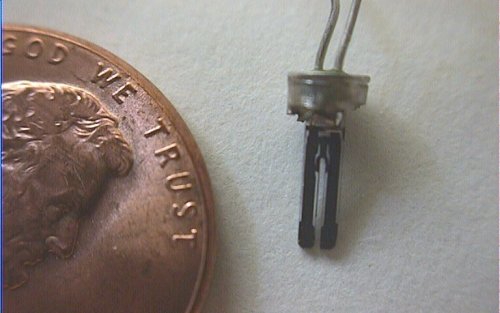
Accutron Watch Page reader and Physicist Erhard Schreck sent this excellent pic of a 32,768 Hz quartz crystal with its cover removed, to show a typical example of a quartz watch tuning fork. Next to it is a 1 cent coin to give you an idea of size.

So why do we ignore quartz watches here, even though they are tuning fork watches? I guess the distinction we Accutron enthusiasts draw between quartz resonators and the metal resonators in Accutrons is in the way the energy of vibration of the fork is used, not only to keep the resonator vibrating, but to extract the energy to operate the watch. A very brief comparison follows:
The Quartz Tuning Fork WatchIn a quartz watch, the fork is kept vibrating by an oscillator circuit which supplies a voltage to a thin-film metal layer deposited on both sides of the crystal. This takes advantage of the piezo-electric nature of quartz to cause it to vibrate, and the quartz crystal itself is a capacitive component of that oscillator circuit. The varying voltage of this circuit is detected, and then divided down electronically to become a 1Hz signal which is used to drive a stepper motor.
A block diagram of a quartz watch may look like this:In an Accutron tuning fork watch, the fork is likewise kept vibrating by an oscillator circuit, though in this case the fork is an inductive component of that oscillator. But this is where quartz watches and Accutrons go their own sweet ways, because the energy of the Accutron fork is directly used to drive the gear train, extracted mechanically by the index mechanism. The fork and index mechanism combined can be thought of as a stepper motor. The electronics do nothing but keep the fork vibrating.
A block diagram of an Accutron watch may look like this:Regardless of those technicalities....
the Bulova Accutron is still the world's first true electronic watch, and as such has a special place in technological history. The Accutron is the result of skilled craftsmanship, talented designers, watchmakers, engineers and draftsmen. No fancy computer-aided design went into these watches, and as a result they contain a little bit of the personality of all the men and women involved in their creation. Perhaps this is one of the reasons why quartz watches, which are mainly designed on computers, are considered by watch collectors and enthusiasts the world over as "soul-less".